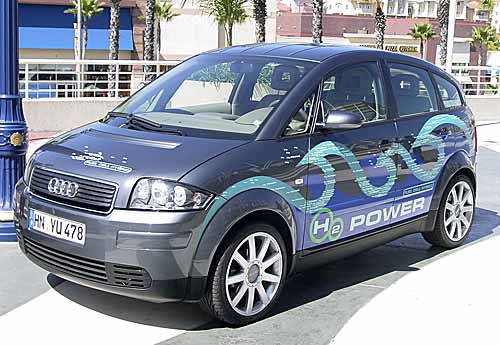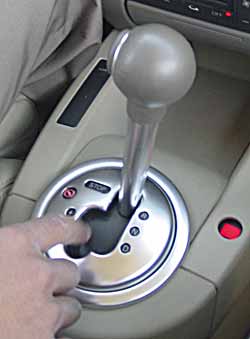The Audi Hydrogen A2 car (dubbed A2H2) combines the high-tech environmentally friendly design of a green H2 vehicle with the peppiness of a small sports car. The Audi A2H2 uses a Ballard PEM fuel cell stack combined with a high-torque electric motor to accelerate from 0-60 mph in just under 10 seconds. The A2H2 is based upon the Audi A2, which is a popular model in Europe.

Audi A2H2 Hydrogen Car
Audi Hydrogen A2H2 car during the NHA Annual Hydrogen Conference 2006 at the Long Beach Convention Center in Long Beach, California. I also had the further pleasure to be quickly passed by the Audi A2H2 as I was driving another Volkswagen hydrogen vehicle, the HyMotion in a caravan of six other hydrogen vehicles, who were all taking a spin around the block. With much glee (and a bit of a lead-foot), the driver who shall remain nameless, passed us at quite a clip and may have very well gotten a speeding ticket, which in my opinion would have done all the more to promote hydrogen cars had this incident made the 11 O'Clock news.
The Audi Hydrogen A2H2 car has a top speed of 109 mph, a range of 137 miles and an effective efficiency of 94 mpg. The Audi A2H2 contains three Dynetek hydrogen storage tanks at a pressure of 350 bar, for a total capacity of 1.8 kg (3.96 lb.) of compressed hydrogen. What gives the A2H2 its power is the 66 kw synchronous electric motor that delivers up to 425 nm (313 lb.-ft.) torque, which can be powered both directly by the PEM fuel cell as needed and the 38 kw NiMH traction battery pack. This combination can deliver up to 150 bhp (110 kw) for short periods such as for passing another vehicle or for climbing hills.
The Audi Hydrogen A2H2 car has another feature familiar in hybrid vehicles and that is that the A2H2 uses regenerative braking in order to recapture kinetic energy and recharge the battery pack.
 Audi A2H2 Shifter | In start mode is the only time that the Audi A2H2's entire system is supplied with electricity from the battery and the only time the electrical current flows from the battery to the fuel cell system. |
No comments:
Post a Comment